But unlike other modern cities Marseilles had a character of its own, being one of the oldest and sunniest city of France!
2600 years Phoenicians from Turkey and Greece used to trade at this port with local tribes for olives, wines or ceramics. It was known to the ancient Greeks as Massalia and to Romans as Massilia, before the French called it Marseilles. Now a lot of the old port area has been reclaimed.
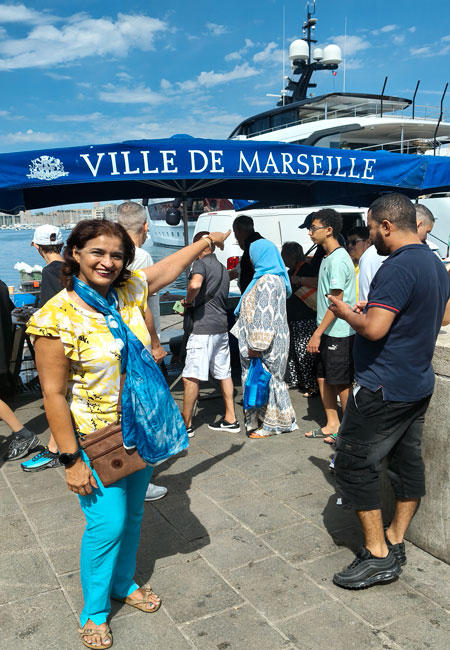
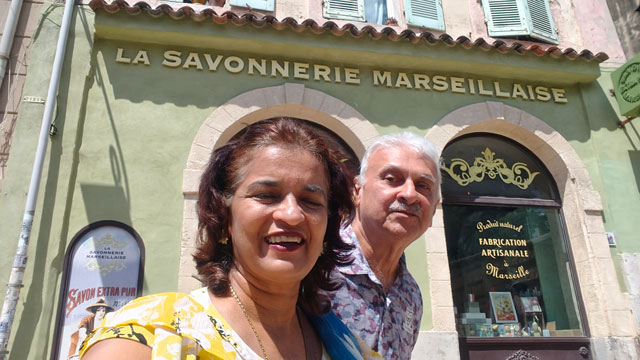
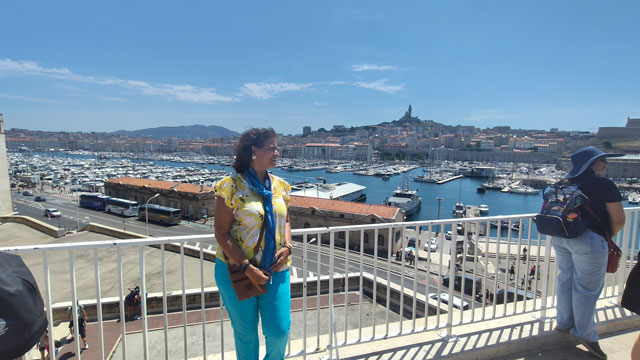
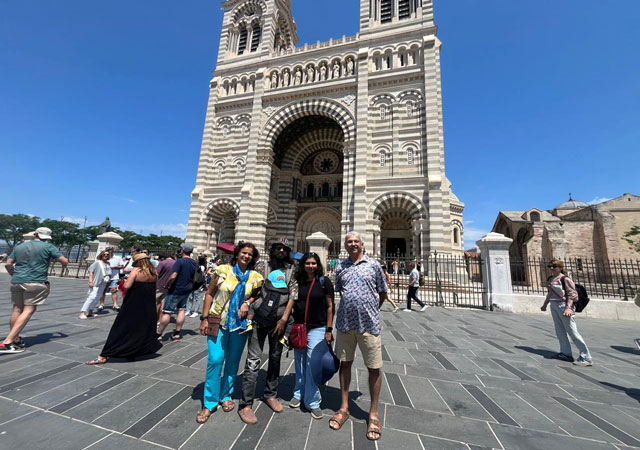
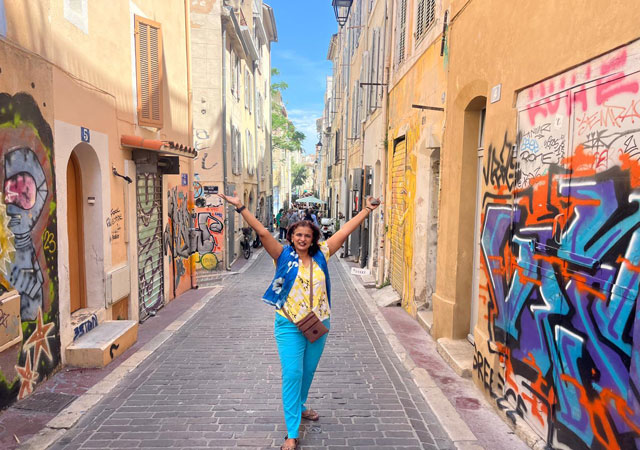

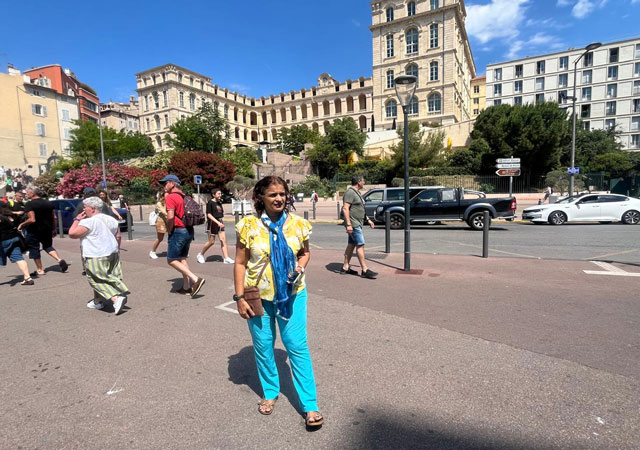
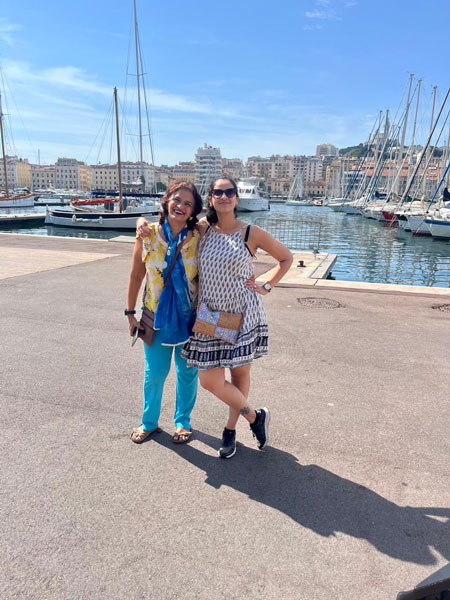
We walked towards another part of the city which in 1666 was considered as a luxury boulevard. Centuries later the reputation of Marseilles got changed from being a pretty city to a crime risk city after the King of Yugoslavia 1934 was murdered and even now some areas are best avoided by tourists at night. The movie French connection in 1980s depicted the mafia association domination at Marseilles.
In 2013 the city was chosen by EU to get a facelift, with new museums, and a program to make the city more pedestrian friendly. What used to be a parking spot till 1967, made way for a History Museum of Marseilles and surprisingly they found the ruins of what used to be ancient entry point of the city. So they integrated both a shopping centre along with a museum, above the old ruins!
I remembered my first visit in awe to the famous Galleries Laffayette shopping centre at Paris in 2003, and this time in Marseilles, I just walked past it with no inclination for shopping at all.
We then entered the oldest street called Grand Street with quaint buildings on either side. France had become a colonial power, and had to to build a train station in this area. So the rich citizens of Marseilles decided to move away from the downtown area and stay in the exclusive hills nearby.
In the 1800s Paris was rebuilt by Georges-Eugène Haussmann, who also resigned this street trying to copy the Champs De Slysee. He ensured that all the buildings were of one size to make city look better. He used different angles, made useless yet beautiful balconies.
However most of the rich never came back to stay here, and these buildings were destroyed from inside. It became an expensive commercial area for big brands paying around 5000 euros for 70 square metres of space but even they could not stay for long.
'Potential of Marseilles is there, however there seems to be no direction or no confidence or trust in Marseilles'.....as observed by our History buff guide! It became a City of Duality with some rich Parisians still buying property in Marseilles that the locals couldn't afford.
We walked further to an area that was used to build bunkers during the time of the World war. The people who came from elsewhere to the south of France displaced around 30000 non French speaking people in just one hours time and sent away around 6000 jews out of the city!
A majestic looking building that we saw was actually a Hospital in 1593, then got converted now to become one of the most expensive 5 star Inter Continental hotel of Marseilles charging around 1400 euro per night!
We walked past another majestic building called the Hotel de Ville which used to be a court of Justice with a prison attached. It also had a guillotine which was used last in 1977 in Marseilles as death penalty for a Tunisian man accused of rape and murder.
During the war, another important building called Maison Diamantée was the Command centre which had secret underground connection to the prison too. Its exterior facade featuring diamond-shaped stone carvings still displays this Italian diamond shaped architecture which is rarely found anywhere else in the world.
Our guide pointed out to the church of Mary with Baby Jesus on a hill, called the Notre Dame de la garde, which was used as an observation point during the war due to the vantage views from there. This 1500s Basicillica was used as a military base, and fortified too during the war.
We then entered Le Paneer or the Old Quarter area which still retained its ancient ethos, simply because it was on the hills and it required extra effort to be destroyed by the Nazi invaders during the war! I peeked into an interesting store selling the authentic Marsellies made soaps that is supposed to have many medicininal properties.
This simple looking picturesque neighbourhood was considered dangerous before 2013. After that with extra lights and camera points, action was taken to maintain cleanliness and the trash was actually picked up everyday.
It was wonderful to walk along the narrow, winding streets beneath colorful buildings, and admire the buildings of Greek, Roman, and medieval architecture. The bold local art all around the hill brings more tourists to this side of Marseilles. The changing Graffiti is the essence of Marseilles which started as the form of protest more than 1000 years ago. I even saw the Space Invader video game characters shown in Marseilles art. Suddenly our group was almost ambushed by two locals screaming on a bike.
Our guide recommended lunch of a kind of famous stew made from four types of Fish, boiled and simmered for 9 hours, costing from 35 to 60 to 400 euros for this traditional dish. French rose wine is widely consumed during Summer.
We also saw some locals playing a chilled out game called Petanque in Marsellies with 3 balls per player... Reminding me of how we used to play with marbles as kids.
We then saw the majestic Major Cathedral with unique striped exterior walls (which was not supposed to be taller than Mary's basilica on the hill), constructed at the entry point of Marseilles to demonstrate at the might of the French Colonial power to the slaves who were brought in from the colonies. Part of the 900 year old church was destroyed to make way for the new church, and part of it was retained due to protest from the locals at the time of its construction. So we could easily see the difference between the old side and the new grand side in Neo Byzantine style, with its stripes, arches, and 10 million pieces of mozaic used in its very impressive interiors.
As kids we were fascinated with the Doordarshan serial called the Count of Monte Cristo, and I was thrilled to see the Chateau d'If, in the distance - a fortified island outside of Marseilles, made historic for the daring escape of the Count from its prison, around 400 years ago.
If we had more time another day trip could be made to the Calanques National Park for beautiful scenery after lots of hiking.
We had now reached reached the new port area which was L shaped and naturalled protected the boats from strong winds.
After 2013, this industrial and criminially dangerous zone was cleaned up and made into a museum. A cave was discovered in the city centre. From afar, we saw how the old fort of St. John and fort of St. Nicholas, was also converted into a cool museum with a bridge in between. The city officials made a record number of 3 museums in just 7 months.
Our final stop was at an viewpoint where we got an impressive birds eye view of Marseilles. I love these walking tours, by energetic guides who provide their unique insights about a city which can never be found on Google ( just like this article which is based on personal experience without using the support of AI).
Our large family found a large taxi to take us back to the cruise ship with pleasant smiling memories of this short yet sweet visit to the French city of Marseilles!